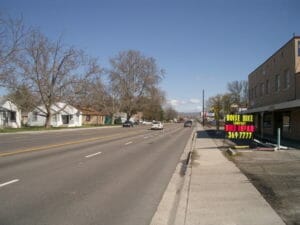Boise, ID
Vista Avenue
About the Corridor
ULI Idaho and partners are working on a 1.7 mile segment of a 4 mile, 4 lane arterial connecting the airport, Interstate 84, Boise State University, and downtown Boise. Vista Avenue exemplifies a typical strip commercial street, with auto-oriented retail, bars, pawn shops, a mix of converted and dilapidated housing, and very few pedestrian facilities. This segment of the corridor bifurcates the Vista Neighborhood, which has some of the lowest livability indicators (income, single family home value, etc.) in the city, and includes a mix of single and multi-family housing. Due to the function of this corridor as a gateway to the city and the lack of relationship to the surrounding neighborhoods, there is a lot of opportunity to improve the uses and infrastructure along Vista Avenue to make it more attractive to visitors, while simultaneously improving the health and well-being of residents who rely on the corridor as part of their daily lives.
Local Workshop
The Boise local workshop took place on June 18th, 2015. The workshop included an insightful walking tour with photos shared with everyone immediately afterwards. Diverse participants attended, including both community stakeholders and agency representatives. Key issues coming out of the workshop include improving pedestrian access, reducing lane widths and speeds, and working with business owners to get buy-in on improvements and reinvestment. Next steps include developing a vision for the corridor with comprehensive engagement and diverse support, and looking at cosmetic improvements.
To read more about other demonstration corridors’ local workshops, click here.
National Study Visit
Vista Avenue runs from the airport to downtown, and serves as a de facto “gateway,” which the local team is interested in capitalizing on to create a stronger identity for the surrounding neighborhoods. The key study questions posed to the study visit participants included:
- How can the Vista corridor public infrastructure be re-configured to improve health & enhance the corridor’s function as a gateway?
- What are key place-making strategies that will create activity and drive on-going re-investment?
- What are successful processes to create and implement a corridor vision plan?
- How can corridor programming and improvements be funded or financed?
- What is the best organizational structure to champion this effort now and over the long haul?
The participant team discussed a set of recommendations to help emphasize the corridor’s role as a gateway and to create a healthier and more vibrant district. Infrastructure, land use, economic development, and a focus on culture, social connectivity, and health are all critical to achieve these goals. Key recommendations included reducing the number of travel lanes from five to three, implementing a form based code to regulate the design and placement of new and redevelopment businesses, and tackling quick wins to engage the community, such as public art or projects to help demonstrate corridor walkability.
The Boise National Study Visit was held February 15-17th, 2016. View final presentation. Read about the National Study Visits for other Demonstration Corridors.
In the News
Urban Land Institute to Boise, ACHD: Vista Neighborhood Isn’t a ‘Gateway,’ It’s a Go-Through
February 18, 2016
Boise Weekly
Experts weigh in on how to make Vista Avenue ‘healthier’
January 22, 2016
Idaho Business Review
Creating a Healthier Commercial Corridor along Boise’s Vista Avenue
September 8, 2015
Urban Land Magazine
Learn More
Read the full Vista Ave case study featured in the Healthy Corridors Report.
